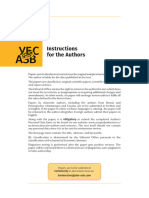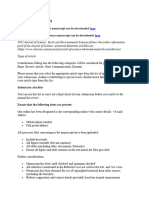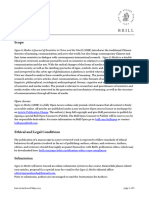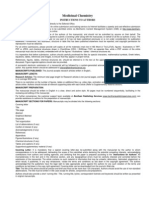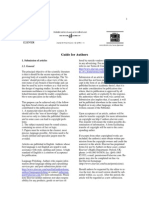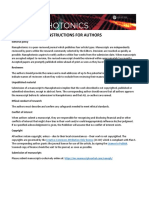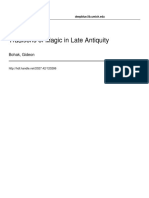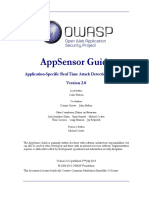Journal of Ancient Near Eastern Religions: Instructions For Authors
Journal of Ancient Near Eastern Religions: Instructions For Authors
Uploaded by
eannatumCopyright:
Available Formats
Journal of Ancient Near Eastern Religions: Instructions For Authors
Journal of Ancient Near Eastern Religions: Instructions For Authors
Uploaded by
eannatumOriginal Title
Copyright
Available Formats
Share this document
Did you find this document useful?
Is this content inappropriate?
Copyright:
Available Formats
Journal of Ancient Near Eastern Religions: Instructions For Authors
Journal of Ancient Near Eastern Religions: Instructions For Authors
Uploaded by
eannatumCopyright:
Available Formats
Journal of Ancient Near Eastern Religions
brill.com/jane
Instructions for Authors
Scope
The Journal of Ancient Near Eastern Religions (JANE) focuses on the religions of the Ancient Near East:
Egypt, Mesopotamia, Syria-Palestine, and Anatolia, as well as adjacent areas under their cultural
influence, from prehistory through the beginning of the common era. JANE defines Ancient Near Eastern
civilization broadly as including not only the Biblical, Hellenistic and Roman world but also the impact
of Near Eastern religions on the western Mediterranean. JANE is the only peer-refereed journal
specifically and exclusively addressing this range of topics, and is intended to provide an international
scholarly forum for studies on all aspects of ancient religions. JANE welcomes submissions that introduce
new evidence, revise old understandings, and advance debates on ancient Near Eastern ideas and
practices of the otherworldly.
Ethical and Legal Conditions
The publication of a manuscript in a peer-reviewed work is expected to follow standards of ethical
behavior for all parties involved in the act of publishing: authors, editors, and reviewers. Authors, editors,
and reviewers should thoroughly acquaint themselves with Brill’s publication ethics, which may be
downloaded here: brill.com/page/ethics/publication-ethics-cope-compliance.
Online Submission
The Journal of Ancient Near Eastern Religions uses Editorial Manager, a web based submission and peer
review tracking system. All manuscripts should therefore be submitted online at
editorialmanager.com/jane.
First-time users of EM need to register first. Go to the website and click on the "Register Now" link in the
login menu. Enter the information requested. During registration, you can fill in your username and
password. If you should forget your Username and Password, click on the "send login details" link in the
login section, and enter your e-mail address exactly as you entered it when you registered. Your access
codes will then be e-mailed to you. When submitting via the website, you will be guided stepwise
through the creation and uploading of the various files.
A revised document is uploaded the same way as the initial submission. The system automatically
generates an electronic (PDF) proof, which is then used for reviewing purposes. All correspondence,
including the editor’s request for revision and final decision, is sent by e-mail.
Please make sure to consult the Instructions to Authors prior to submission to ensure your submission is
formatted correctly.
Double-blinded Peer Review
JANE uses a double-blind peer review system, which means that manuscript author(s) do not know who
Last revised on 19 November 2019 page 1 of 5
Journal of Ancient Near Eastern Religions
brill.com/jane
Instructions for Authors
the reviewers are, and that reviewers do not know the names of the author(s). When you submit your
article via Editorial Manager, you will be asked to submit a separate title page that includes the full title
of the manuscript, the names and complete contact details of all authors, the abstract, keywords, and
any acknowledgement texts. This page will not be accessible to the referees. All other files (manuscript,
figures, tables, etc.) should not contain any information concerning author names, institutions, etc. The
names of these files and the document properties should also be anonymized.
Contact Address
For any questions concerning the journal, please contact Professor Abraham Winitzer (Notre Dame), e-
mail: Winitzer.1@nd.edu. For questions concerning Editorial Manager, authors can contact the Brill EM
Support Department at: em@brill.com.
Submission Requirements
Because the journal is intended for an unusually diverse scholarly audience, articles must make clear
what issue in the study of religion is at stake. We welcome highly specialized articles but they must
explain where the article’s arguments fit into a larger picture, and end with some assessment of what has
been learned. The introduction and conclusion should be intelligible to scholars who are not specialists
in the subject under investigation.
Language
Manuscripts will be accepted in English. Spelling (British or American) should be consistent throughout.
Orthography
An author's priority should be consistency; transliteration of words and proper names in Greek, Arabic,
Hebrew, etc., should be consistent throughout. In general, please consult The Chicago Manual of Style,
16th ed. (Chicago: University of Chicago Press 2010; also available online at
chicagomanualofstyle.org/home.html for guidance.
Special Characters
Ideally all diacritics should be in Unicode. For writers unfamiliar with Unicode, all characters that do not
appear in the standard Roman alphabet (i.e., accented letters, diacritical marks) should be very plainly
identified.
Transliteration of Hebrew
Follow brill.com/fileasset/downloads_static/static_fonts_scholarlyhebrewtransliteration.pdf.
Last revised on 19 November 2019 page 2 of 5
Journal of Ancient Near Eastern Religions
brill.com/jane
Instructions for Authors
Manuscript Structure
Format
Wide margins of at least 2.5 cm (1 inch) are to be left on all edges of the page. All parts (abstract, body,
footnotes, etc.) must be double-spaced and numbered consecutively.
Presentation
The first page of the manuscript should carry the full title of the article and the name and affiliation of
the author, followed by the Abstract.
The remaining manuscript should be arranged in the following sequence:
Main article (with footnotes), bibliography or reading list (if any), appendices (if any), figure captions (if
any), tables (if any), and figures.
Acknowledgements should be addressed as a non-numbered footnote which will appear before the first
footnote.
Abstracts
Abstracts should not exceed 150 words in English and include a concise description of the article’s
hypothesis, methods, main sources, and results.
Keywords
Authors should provide keywords.
Headings
1 Introduction
The text.
1.1 The Second Level Heading
The text.
Footnotes
Notes should be numbered consecutively throughout the text and follow any punctuation marks, such as
a period or comma, within the text. References should be included within the notes (but any Reading
List or Bibliography can be presented as the final section of the paper). Take care as to ensure that each
footnote reference appears in the appropriate position in the text.
Last revised on 19 November 2019 page 3 of 5
Journal of Ancient Near Eastern Religions
brill.com/jane
Instructions for Authors
Italics
Please italicize matter that is intended to be italicized.
Quotations
Direct quotations of fewer than twenty-five words should be enclosed in double quotation marks (“ ”)
and run on in the text. Double quotation marks should also be used for titles of articles from journals
and reference works. Single quotation marks (‘ ’) are used to enclose words and phrases within double
quotation marks.
Block Quotations
Larger sections of quoted text (i.e. anything over twenty-five) should be set off from other text by adding
a blank line above and below the section and indenting the entire quotation 1.5 inches from the left.
These larger sections, or block quotations, are not enclosed in quotation marks.
Publication
Proofs
Upon acceptance, a PDF of the article proofs will be sent to the each author/ the designated author by e-
mail to check carefully for factual and typographic errors. Authors are responsible for checking these
proofs and are strongly urged to make use of the Comment & Markup toolbar to note their corrections
directly on the proofs. At this stage in the production process only minor corrections are allowed.
Authors’ alterations in excess of 10% of the original composition cost will be charged to authors. Proofs
should be returned within one week of receipt.
E-offprints
A PDF file of the article will be supplied free of charge by the publisher to authors for personal use. Brill
is a RoMEO yellow publisher. The Author retains the right to self-archive the submitted (pre-peer-review)
version of the article at any time. The submitted version of an article is the author's version that has not
been peer-reviewed, nor had any value added to it by Brill (such as formatting or copy editing). The
Author retains the right to self-archive the accepted (peer-reviewed) version after an embargo period of
12 months. The accepted version means the version which has been accepted for publication and
contains all revisions made after peer reviewing and copy editing, but has not yet been typeset in the
publisher’s lay-out. The publisher’s lay-out must not be used in any repository or on any
website (brill.com/resources/authors/publishing-books-brill/self-archiving-rights).
Last revised on 19 November 2019 page 4 of 5
Journal of Ancient Near Eastern Religions
brill.com/jane
Instructions for Authors
Consent to Publish
Transfer of Copyright
By submitting a manuscript, the author agrees that the copyright for the article is transferred to the
publisher if and when the article is accepted for publication. For that purpose the author needs to sign
the Consent to Publish which will be sent with the first proofs of the manuscript.
Open Access
Should the author wish to publish the article in Open Access he/she can choose the Brill Open option.
This allows for non-exclusive Open Access publication under a Creative Commons license in exchange
for an Article Publication Charge (APC), upon signing a special Brill Open Consent to Publish Form.
More information on Brill Open can be found on brill.com/brillopen.
Last revised on 19 November 2019 page 5 of 5
You might also like
- Regedit XLR8 FFXXDocument5 pagesRegedit XLR8 FFXXdannminielNo ratings yet
- Haider Raad - Fundamentals of IoT and Wearable Technology Design-Wiley-IEEE Press (2021)Document290 pagesHaider Raad - Fundamentals of IoT and Wearable Technology Design-Wiley-IEEE Press (2021)Vikash SandhuNo ratings yet
- Test Cases For Login Page: Test Case S Feature Description Steps To Execute Expected ResultsDocument2 pagesTest Cases For Login Page: Test Case S Feature Description Steps To Execute Expected Resultsnaimish khan50% (2)
- Mecal: Ecu Calibration SoftwareDocument58 pagesMecal: Ecu Calibration SoftwarecastrokermanNo ratings yet
- NuMen SubmissionsDocument8 pagesNuMen SubmissionsozergyalmoNo ratings yet
- Call For Papers n20Document5 pagesCall For Papers n20David GarcíaNo ratings yet
- European Journal of Jewish Studies: Instructions For AuthorsDocument13 pagesEuropean Journal of Jewish Studies: Instructions For AuthorschinguardNo ratings yet
- The Soviet and Post-Soviet Review: Instructions For AuthorsDocument5 pagesThe Soviet and Post-Soviet Review: Instructions For AuthorsiakounivNo ratings yet
- 1532953475wpdm_Authors GuidelineDocument4 pages1532953475wpdm_Authors Guidelinekassyemariyam21No ratings yet
- Creative Flight Journal - HomeDocument5 pagesCreative Flight Journal - HomeApurba SarkarNo ratings yet
- Indique Law Journal GuidelinesDocument12 pagesIndique Law Journal GuidelinesAryan MewadaNo ratings yet
- EEM StylesheetDocument4 pagesEEM StylesheetJelenaJosijevićNo ratings yet
- Submissions - The International Journal of Traditional ArtsDocument8 pagesSubmissions - The International Journal of Traditional ArtsRory CorbettNo ratings yet
- For AuthorsDocument4 pagesFor AuthorsxprakashNo ratings yet
- Jurnal Tugas PentingDocument10 pagesJurnal Tugas PentingMuhammad DarwisNo ratings yet
- Agricultural and Forest Entomology - Author GuidelinesDocument4 pagesAgricultural and Forest Entomology - Author Guidelinesmib_579No ratings yet
- Author's GuidelinesDocument13 pagesAuthor's GuidelinesHabtamuNo ratings yet
- Ipq A Note For AuthorsDocument1 pageIpq A Note For AuthorsVISHRUT KUMARNo ratings yet
- UputstvoZaAutore EngDocument3 pagesUputstvoZaAutore EngfullvedoNo ratings yet
- Author's Guidelines: Guidelines For Manuscript SubmissionDocument3 pagesAuthor's Guidelines: Guidelines For Manuscript SubmissionEllen AngelNo ratings yet
- Template InderscienceDocument2 pagesTemplate InderscienceHillgaNo ratings yet
- Stylesheet: - Guidelines For Contributors Page: 1 / 2Document2 pagesStylesheet: - Guidelines For Contributors Page: 1 / 2LauraPalmerNo ratings yet
- Aims and ScopeDocument10 pagesAims and ScopetfemilianNo ratings yet
- JTC_Instructions for Authors and Editorial Policy_JTCDocument6 pagesJTC_Instructions for Authors and Editorial Policy_JTCrgiatocNo ratings yet
- AIJBSR-Manuscript Format Style GuideDocument2 pagesAIJBSR-Manuscript Format Style GuideNisha NishaNo ratings yet
- Guidelines For Authors Member Countries 21.1.2022.v2Document13 pagesGuidelines For Authors Member Countries 21.1.2022.v2Ashique RajputNo ratings yet
- Regras de Submissão - Journal of Autism and Developmental DisordersDocument20 pagesRegras de Submissão - Journal of Autism and Developmental DisordersJoão CabralNo ratings yet
- Annamalai International Journal of Business Studies and Research AijbsrDocument2 pagesAnnamalai International Journal of Business Studies and Research AijbsrNisha NishaNo ratings yet
- GuidelineDocument4 pagesGuidelinejjfarizaNo ratings yet
- Instructions To AuthorDocument2 pagesInstructions To Author05 Umesh DhaaraniNo ratings yet
- Food Research - Author GuidelinesDocument8 pagesFood Research - Author GuidelinesAngel GustasianaNo ratings yet
- thể lệ Viết bài TC Đại học Quốc giaDocument9 pagesthể lệ Viết bài TC Đại học Quốc giagiangdhNo ratings yet
- IJAPS Guide To Authors Updated 2021Document7 pagesIJAPS Guide To Authors Updated 2021Muhammad Alzaki TristiNo ratings yet
- Historical Materialism: Instructions For AuthorsDocument10 pagesHistorical Materialism: Instructions For AuthorsLuiz PereiraNo ratings yet
- Normas Bioresource TechnologyDocument8 pagesNormas Bioresource TechnologyBruna Barcelos CardiasNo ratings yet
- ARABDocument24 pagesARABhind hindNo ratings yet
- JBE-Instructions For AuthorsDocument16 pagesJBE-Instructions For AuthorsUsman KokabNo ratings yet
- GuidanceDocument3 pagesGuidanceBunga SepwiatiNo ratings yet
- PublicationNorms2022 PDFDocument5 pagesPublicationNorms2022 PDFCosas DiversasNo ratings yet
- Instructions For AuthorsDocument6 pagesInstructions For AuthorsAdrian NugrahaNo ratings yet
- SIMEDocument5 pagesSIMEkatlego01No ratings yet
- JIB - Instructions For AuthorsDocument5 pagesJIB - Instructions For AuthorsIhsanul AriefNo ratings yet
- Preparing Your MaterialsDocument8 pagesPreparing Your MaterialsNona NemsadzeNo ratings yet
- 4. Guideline for AuthorsDocument3 pages4. Guideline for Authorsdagmawi kassahunNo ratings yet
- Medicinal Chemistry: Instructions To AuthorsDocument5 pagesMedicinal Chemistry: Instructions To Authorsabhijeet_sangwanNo ratings yet
- Journal of Islamic Ethics, Instructions For AuthorsDocument14 pagesJournal of Islamic Ethics, Instructions For Authorssubscribed14No ratings yet
- Guide For Authors: 1. Submission of ArticlesDocument7 pagesGuide For Authors: 1. Submission of ArticlesMarcia Correa PintoNo ratings yet
- Guidelines For AuthorsDocument3 pagesGuidelines For Authorsapi-405983256No ratings yet
- #Guide To AuthorsDocument6 pages#Guide To Authorsngmthao198No ratings yet
- NANOPH - Instructions For AuthorsDocument4 pagesNANOPH - Instructions For AuthorsGerardo LopezNo ratings yet
- TBC JournalDocument3 pagesTBC JournalMissri YuniarNo ratings yet
- Alta 11 PaperinstructionsDocument4 pagesAlta 11 PaperinstructionsDavid HingstmanNo ratings yet
- Basin Research - Journal InformationDocument3 pagesBasin Research - Journal Informationbrando2011No ratings yet
- ContentsDocument7 pagesContentsTyrant Krish IINo ratings yet
- Pacific Health Special Issue Instructions For AuthorsDocument4 pagesPacific Health Special Issue Instructions For AuthorsRandy NovirsaNo ratings yet
- Instructasdaions For Authors 2014Document6 pagesInstructasdaions For Authors 2014Claudiu OvidiuNo ratings yet
- Cejssm Cejssm Instructions For Authors 2023Document3 pagesCejssm Cejssm Instructions For Authors 2023PijarNo ratings yet
- Instructions For Authors Building SimulationDocument12 pagesInstructions For Authors Building SimulationAbdel Kader CheikhNo ratings yet
- Aanat InstructionsDocument1 pageAanat InstructionscoolreflectionNo ratings yet
- Pentecostudies: An Interdisciplinary Journal For Research On The Pentecostal and Charismatic MovementsDocument8 pagesPentecostudies: An Interdisciplinary Journal For Research On The Pentecostal and Charismatic MovementssaortuaNo ratings yet
- JWL - JWL Instructions For AuthorsDocument10 pagesJWL - JWL Instructions For Authorsمحمد بن اسحإقNo ratings yet
- J E T B:, Instructions To AuthorsDocument5 pagesJ E T B:, Instructions To AuthorsAldean YusufNo ratings yet
- 1385002_175103819_Friction-Instructions for authorsDocument13 pages1385002_175103819_Friction-Instructions for authorsAstridNo ratings yet
- 80 Common Layout Errors to Flag When Proofreading Book InteriorsFrom Everand80 Common Layout Errors to Flag When Proofreading Book InteriorsNo ratings yet
- 27) Again On Ent. 28 IV 30-33 // 29 V 17-20 ( RIME 1.9.5.1) - in His Edition of The Presargonic RoyalDocument4 pages27) Again On Ent. 28 IV 30-33 // 29 V 17-20 ( RIME 1.9.5.1) - in His Edition of The Presargonic RoyaleannatumNo ratings yet
- Ceccarelli Bemerkungen Zur Entwicklung Der Beschwor PDFDocument18 pagesCeccarelli Bemerkungen Zur Entwicklung Der Beschwor PDFeannatumNo ratings yet
- Aofo 2018 0012 - v1 PDFDocument24 pagesAofo 2018 0012 - v1 PDFeannatumNo ratings yet
- Traditions of Magic 96Document21 pagesTraditions of Magic 96eannatumNo ratings yet
- Civil Enlil NinlilDocument25 pagesCivil Enlil NinlileannatumNo ratings yet
- The University of Chicago PressDocument8 pagesThe University of Chicago Presseannatum100% (1)
- Careandfeedingvios Aug2117Document46 pagesCareandfeedingvios Aug2117Jayson JHBZANo ratings yet
- Checklist For The LLM Application ProcessDocument4 pagesChecklist For The LLM Application ProcesselectronionNo ratings yet
- CSS Chapter 2.1Document28 pagesCSS Chapter 2.1Raymond PunoNo ratings yet
- MCSA MCSE 70 291 Exam Cram Implementing Managing and Maintaining A Microsoft Windows Server 2003 Network Infrastructure 2nd Edition Diana HugginsDocument84 pagesMCSA MCSE 70 291 Exam Cram Implementing Managing and Maintaining A Microsoft Windows Server 2003 Network Infrastructure 2nd Edition Diana HugginsanconizitroNo ratings yet
- Anybus Modbus-TCP/RTU Gateway: User ManualDocument22 pagesAnybus Modbus-TCP/RTU Gateway: User Manualyana sopian hidayatNo ratings yet
- Managed Fortiswitch 604Document109 pagesManaged Fortiswitch 604DiegoNo ratings yet
- Dice Resume CV Kenton FalanaDocument4 pagesDice Resume CV Kenton FalanaD' WayNo ratings yet
- Test Portal: Vulnerability Assessment & Penetration TestingDocument12 pagesTest Portal: Vulnerability Assessment & Penetration Testingabdul hadiNo ratings yet
- APIPA (Automatic Private IP Addressing)Document5 pagesAPIPA (Automatic Private IP Addressing)Giri RajNo ratings yet
- Wireless Authentication MethodsDocument4 pagesWireless Authentication MethodsAhmed JahaNo ratings yet
- Ie Eiabc Netapp Atp v0.2Document8 pagesIe Eiabc Netapp Atp v0.2birukNo ratings yet
- Advantech AE Technical Share Document: Install - G - Unsafe-Perm Node-REDDocument4 pagesAdvantech AE Technical Share Document: Install - G - Unsafe-Perm Node-REDJaime VargasNo ratings yet
- Edge Computing - Unit 11 - Week 8 - NVF-SDN and Resource Allocation in Edge-Cloud SystemsDocument3 pagesEdge Computing - Unit 11 - Week 8 - NVF-SDN and Resource Allocation in Edge-Cloud Systemsnripendra972000No ratings yet
- User ManualDocument54 pagesUser Manualcajepe5261No ratings yet
- ReportoverDocument36 pagesReportover1DA16CS126 the KINGNo ratings yet
- Dynamics 365 Best PracticesDocument30 pagesDynamics 365 Best PracticesAsfar Khan100% (1)
- Module 1 Information and Communication Technology - Week 1Document16 pagesModule 1 Information and Communication Technology - Week 1Claire AlvaranNo ratings yet
- GMT20240420-015927 RecordingnewChatDocument3 pagesGMT20240420-015927 RecordingnewChatsinghchandanpreet5No ratings yet
- Authorized Mobility PartnersDocument90 pagesAuthorized Mobility PartnersGerardoNo ratings yet
- Owasp Appsensor Guide v2 PDFDocument204 pagesOwasp Appsensor Guide v2 PDFBoomKingsizeNo ratings yet
- Chapter 3 - Network Protocols and Communications PDFDocument42 pagesChapter 3 - Network Protocols and Communications PDFcruder50No ratings yet
- Ensayo Sobre La Corrupción PolicialDocument5 pagesEnsayo Sobre La Corrupción Policialewadf348100% (2)
- Registrar User ManualDocument64 pagesRegistrar User ManualMohammad AnasNo ratings yet
- Selenium PythonDocument53 pagesSelenium Pythonnikhilgr50% (2)
- National Post Doctoral Fellowship (N PDFDocument4 pagesNational Post Doctoral Fellowship (N PDFPramod AGNo ratings yet
- SGGSCC 29062 PDFDocument3 pagesSGGSCC 29062 PDFManav JainNo ratings yet


















